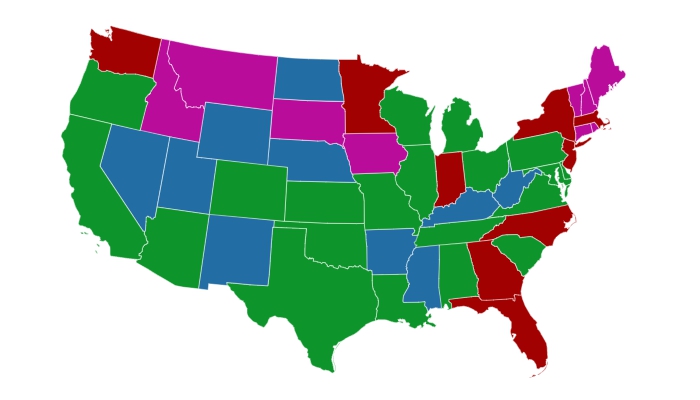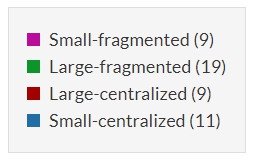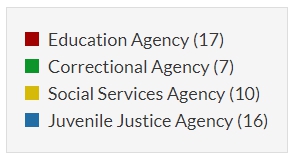Education in Juvenile Justice and Adult Corrections
About the Program
A national collaboration was developed with the goal of assisting states in implementing No Child Left Behind (NCLB) requirements for juvenile justice education. By creating and maintaining partnerships and collaboration among states, this program enabled them to share information and resources that greatly improved their ability to provide effective education and meet different requirements of NCLB.
NCLB required that states provide high quality educational services to incarcerated youth. States faced many challenges in accomplishing this, including lack of resources for effective program evaluation, hiring of highly qualified teachers, developing statewide data management systems, and overcoming past educational deficiencies of delinquent youths.
TThis project formed collaborations and built working partnerships among states. Furthermore, it determined states’ current juvenile justice education evaluation capacity, tracked the progress of each state’s implementation of NCLB requirements, identified common problems for all states, and helped to ensure that the NCLB requirements were implemented appropriately with an established consensus. The project aimed to provide technical assistance and training to the states.
A National Collaboration: Project Goals
The Juvenile Justice No Child Left Behind (NCLB) Collaboration Project was focused on facilitating collaboration nationwide for implementing the requirements of the NCLB Act as they pertained to juvenile justice education. The project’s primary purpose was to develop a national agenda for research and policy as they related to juvenile justice education and the implementation of NCLB requirements.
State Structures in Juvenile Justice Education
States are categorized according to the degree of administrative centralization for juvenile justice education services and the size of the state’s juvenile justice population. Institution types include detention centers, locally operated programs, privately operated programs and state-operated juvenile institutions.
- Centralized systems are characterized by having one or two state agencies working jointly to oversee all juvenile justice education services within the state.
- Decentralized systems have at least one type of juvenile justice institution (such as detention centers, locally or privately operated facilities) or one geographic region within a state not overseen by the state agency ultimately responsible for juvenile justice education.
National residential census data of juvenile justice populations were gathered from the Office of Juvenile Justice and Delinquency Prevention1 and were utilized to classify each state as large (juvenile justice population of 1,400 or over) or small (population of under 1,400).

 Twenty-two states had a juvenile justice population less than 1000, with as few as 51 youth in Vermont; 17 states had populations that ranged between 1000 and 2000 youth; and 11 states had more than 2000 youth in their juvenile justice system, with as many as 16,782 in California.
Twenty-two states had a juvenile justice population less than 1000, with as few as 51 youth in Vermont; 17 states had populations that ranged between 1000 and 2000 youth; and 11 states had more than 2000 youth in their juvenile justice system, with as many as 16,782 in California.
In 20 states, the administration and oversight of juvenile justice education is centralized. Variations of decentralized juvenile justice education systems included states where the agency responsible for the administration and evaluation of juvenile justice education does NOT oversee education services in locally operated detention facilities (12 states), privately operated facilities (13 states), and locally operated commitment facilities (10 states).
Other variations of decentralized systems included:
- One state having a split system where one agency oversees education services in detention centers, while another agency oversees these services in all of the states residential commitment programs.
- Two states having separate geographic regions operating independently from the primary state agency responsible for juvenile justice education.

 The two most common types of agencies responsible for juvenile justice education are State Education Agencies in 17 states and State Juvenile Justice Agencies in 16 states. State Social Services Agencies, responsible for special populations other than delinquent youth such as Departments of Health and Human Services, are responsible for juvenile justice education in 10 states.
The two most common types of agencies responsible for juvenile justice education are State Education Agencies in 17 states and State Juvenile Justice Agencies in 16 states. State Social Services Agencies, responsible for special populations other than delinquent youth such as Departments of Health and Human Services, are responsible for juvenile justice education in 10 states.
Correctional Agencies, also responsible for adult populations, are responsible for education services in 7 states. In 12 states, more than one agency shares responsibility for the oversight of juvenile justice education. The general trend is a state Juvenile Justice Agency collaborating with a State Education Agency. In addition, there are 16 states in which juvenile justice education services operate as an independent correctional school district, however, administrative oversight is still provided by a state agency.
This information highlights the difference among the juvenile justice education organizational structures throughout the United States. The NCLB project staff selected four specific states to conduct in-depth case studies that describe the current state of juvenile justice education and how NCLB has impacted these systems and services. Links to the four cases studies are listed below:
- Case Study Methods
- Delaware Case Study
- New Mexico Case Study
- Massachusetts Case Study
- Virginia Case Study
Contacts
Principal Investigator: Thomas Blomberg, Dean and Sheldon L. Messinger Professor of Criminology
Project Director: George Pesta, Ph.D.
Graduate Students: Colby Valentine and Carla Wright
Researcher: Sabri Ciftei
Dates: 2005-2008
Sponsor Agency: Office of Juvenile Justice and Delinquency Prevention
Amount: $2 million

